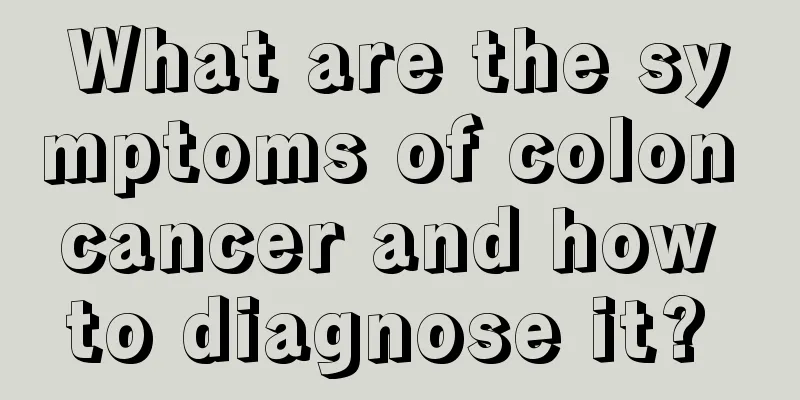What are the symptoms of colon cancer and how to diagnose it?

|
http://www..com.cn/zhongliu/jca/(1) Abdominal pain and digestive irritation symptoms: Most patients experience varying degrees of abdominal pain and discomfort, such as dull abdominal pain, right-sided abdominal fullness, nausea, vomiting, and loss of appetite. Symptoms often worsen after eating, sometimes accompanied by intermittent diarrhea or constipation. These symptoms can be easily confused with common right lower abdominal chronic appendicitis, ileocecal tuberculosis, ileocecal segmental enteritis, or lymphoma. Hepatic flexure cancer of the colon may present as paroxysmal colic in the right upper abdomen, similar to chronic cholecystitis. It is generally believed that pain in right-sided colon cancer often reflects to the upper part of the navel; pain in left-sided colon cancer often reflects to the lower part of the navel. If the tumor penetrates the intestinal wall and causes local inflammatory adhesions, or forms a local abscess after chronic perforation, the pain site is the site of the tumor. (2) Abdominal masses: Generally, they are irregular in shape, hard in texture, and have a nodular surface. In the early stages of transverse colon and sigmoid colon cancer, there is a certain degree of mobility and mild tenderness. If ascending or descending colon cancer has penetrated the intestinal wall and adhered to the surrounding organs, chronically perforated to form an abscess, or pierced through adjacent organs to form an internal fistula, the mass is mostly fixed, with unclear edges and obvious tenderness. (3) Changes in bowel habits and stool characteristics: These are the results of ulcers and secondary infections caused by tumor necrosis. Bowel habits change due to toxins stimulating the colon. The frequency of bowel movements increases or decreases. Sometimes diarrhea and constipation alternate. There may be abdominal cramps before bowel movements, which are relieved after bowel movements. If the tumor is located lower or in the rectum, there may be symptoms of rectal irritation such as anal pain, difficulty in defecation, or tenesmus. The stool is often unformed and mixed with mucus, pus, and blood. Sometimes it contains a large amount of blood and is often misdiagnosed as dysentery, enteritis, hemorrhoidal bleeding, etc. (4) Symptoms of anemia and chronic toxin absorption: Necrosis and ulceration on the surface of the tumor may cause continuous small amounts of bleeding. The blood mixed with feces is not easy to attract the patient's attention. However, anemia, emaciation, weakness and weight loss may occur due to chronic blood loss, toxin absorption and malnutrition. Late-stage patients may have edema, hepatomegaly, ascites, hypoproteinemia, cachexia and other phenomena. If the tumor penetrates the stomach and forms an internal fistula in the bladder, corresponding symptoms may also occur. (5) Intestinal obstruction and intestinal perforation: caused by mass filling in the intestinal cavity, intestinal stenosis or adhesion outside the intestinal cavity, which often manifests as slowly progressing incomplete intestinal obstruction. Patients in the early stage of obstruction may have chronic abdominal pain accompanied by abdominal distension and constipation, but can still eat. The symptoms are more severe after eating. After treatment with laxatives, enema, Chinese medicine, etc., the symptoms can be relieved. After a long period of repeated attacks, the obstruction gradually tends to be complete. Some patients present with acute intestinal obstruction. In the acute colon obstruction of the elderly, About half of them are caused by colon cancer. When the colon is completely obstructed, the ileocecal valve blocks the backflow of colon contents to the ileum, forming a closed loop intestinal obstruction. The colon from the cecum to the obstruction site can be extremely dilated, and the intra-intestinal pressure continues to increase, rapidly developing into strangulated intestinal obstruction, or even intestinal necrosis and perforation, causing secondary peritonitis. Some patients have atypical previous symptoms and are difficult to make a clear diagnosis before surgery. Cancers located in the cecum, transverse colon, and sigmoid colon can cause intussusception when the intestines move violently. Patients with colon cancer do not necessarily have the above-mentioned typical symptoms. Their clinical manifestations are related to the site of the cancer, the pathological type and the duration of the disease. The colon can be divided into left and right halves with the splenic flexure as the boundary. The two halves are different in terms of embryonic origin, blood supply, anatomical and physiological functions, properties of intestinal contents and common types of cancer. Therefore, there are obvious differences in clinical manifestations, diagnostic methods, surgical methods and prognosis. Colon cancer http://www..com.cn/zhongliu/jca/ |
<<: How to prevent rectal cancer?
>>: What are the specific symptoms of late-stage rectal cancer
Recommend
Is it good to take a bath with lemon slices?
After a day's work, many friends want to take...
How to whiten a dark complexion?
Many people's facial skin is dull and lacks l...
Introduction to the correct steps of washing your hair with ginger water
Ginger is very common. You can use it according t...
Clinically, the symptoms of prostate cancer usually appear
Prostate cancer is a common disease in our daily ...
How to treat acne on the chin? It turns out there are 5 ways
Acne on the chin is a common phenomenon on the fa...
What are the symptoms of patients with advanced liver cancer
The onset of liver cancer is relatively hidden. E...
People should always take precautions against colorectal cancer
Nowadays, the incidence of colorectal cancer is g...
Does dietary fiber really induce liver cancer? These are the factors that cause liver cancer
Recently, an article about "feeding mice wit...
Pain in the 45th vertebra
The human spine is composed of multiple joints an...
Why does the lower right rib hurt?
The ribs can be said to be an important structure...
How to improve communication and coordination skills in a team?
If one can serve as a leader of a team at work, t...
What are the antiviral treatment options for hepatitis C?
Antiviral treatment is indispensable for diseases...
What eye drops to use for itchy and painful eyes
For many people, itchy eyes are always the cause ...
What causes pain and swelling on the left side of the anus?
The health of the anus is very sensitive to peopl...
There are lumps after squeezing out the pimples
Everyone must have experienced acne on their body...









